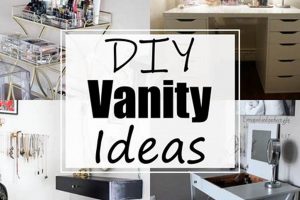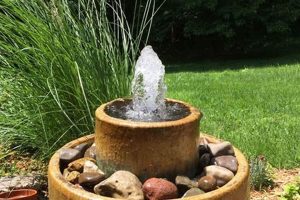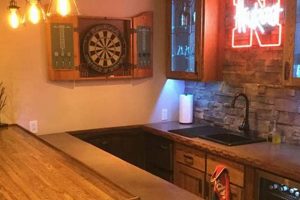Constructing personalized access points to cultivated outdoor spaces involves creative projects that blend functionality with aesthetic appeal. These ventures encompass a range of skill levels and material choices, allowing individuals to tailor entranceways to their specific garden design and personal preferences. For example, one might utilize reclaimed wood to fashion a rustic entryway or repurpose metal components to create a modern, industrial aesthetic.
Such endeavors offer numerous advantages, including cost savings compared to purchasing pre-made structures, the opportunity to express individual artistic vision, and the satisfaction of building something unique and practical. Historically, crafting personalized portals to gardens reflected a deep connection to the land and a desire to create a distinct sense of place. They represent a tradition of resourcefulness and ingenuity, adapting available materials to meet both practical and decorative needs.
The subsequent sections will delve into various approaches for building such structures, exploring design considerations, material selections, and step-by-step instructions to facilitate the successful realization of personalized garden entryways. This includes guidance on framing, gate construction, hinge selection, and latch mechanisms, providing a comprehensive resource for those seeking to enhance their outdoor spaces.
Construction Considerations
This section provides essential guidance to ensure a robust and visually appealing structure. Careful planning and execution are paramount for optimal results.
Tip 1: Precise Measurement and Planning: Accurate measurements are critical. Develop a detailed plan that includes gate dimensions, post spacing, and hardware placement. Inadequate planning can result in structural instability and aesthetic inconsistencies.
Tip 2: Material Selection Based on Climate: Choose materials appropriate for the local climate. Pressure-treated wood is recommended in regions with high humidity or frequent rainfall to prevent rot and decay. Metal components should be treated to resist rust.
Tip 3: Sturdy Frame Construction: The frame is the foundation of the entryway. Employ robust joinery techniques, such as mortise and tenon or reinforced screw connections, to ensure long-term stability. Diagonal bracing can further enhance rigidity.
Tip 4: Proper Hinge Selection and Installation: Select hinges rated for the weight and size of the construction. Securely fasten hinges to both the frame and the supporting post using appropriately sized screws or bolts. Incorrect hinge installation can lead to sagging and operational difficulties.
Tip 5: Leveling and Alignment: Ensure the supporting posts are plumb and the gate frame is level during installation. Shimming may be necessary to compensate for uneven ground. Misalignment can cause operational problems and detract from the overall appearance.
Tip 6: Secure Latching Mechanism: Choose a latch mechanism that provides secure closure and is resistant to tampering. Consider the design aesthetic when selecting a latch, ensuring it complements the overall style of the project.
Tip 7: Protective Finish Application: Apply a protective finish to the completed entryway to enhance its longevity and aesthetic appeal. Paint, stain, or sealant can shield the material from weathering and insect damage.
Adhering to these construction considerations will contribute to a durable, functional, and visually pleasing entryway, enhancing both the security and aesthetic value of the garden.
The following section will present considerations for designing your garden access.
1. Material Suitability
Material suitability is a critical determinant of the longevity and aesthetic performance of garden entryways. The choice of materials directly impacts the structure’s ability to withstand environmental stressors, resist decay, and maintain its visual appeal over time. Inappropriate material selection can lead to premature failure, necessitating costly repairs or replacements. For instance, using untreated softwood in a damp climate will likely result in rot and structural compromise within a short period. The selection process must consider local climate conditions, including humidity levels, temperature fluctuations, and exposure to sunlight and precipitation.
Different materials offer varying levels of resistance to these elements. Pressure-treated lumber, for example, is chemically treated to resist decay and insect infestation, making it a suitable option for regions with high moisture levels. Cedar and redwood possess natural oils that provide inherent resistance to rot, although their cost may be higher. Metal, while durable, is susceptible to rust if not properly treated or coated. Reclaimed materials, such as pallets or salvaged wood, can offer an economical and aesthetically unique option, but their condition and suitability for outdoor use must be carefully assessed. Concrete and composite materials offer enhanced durability and weather resistance, but may require specialized tools and techniques for construction. Ultimately, the optimal material choice depends on a balance of factors, including cost, availability, aesthetic preferences, and environmental considerations.
Selecting appropriate materials is essential for the long-term success of garden entryways. A thorough understanding of material properties, climate conditions, and construction techniques is required to create a structure that is both functional and durable. Neglecting material suitability can result in premature failure and diminished aesthetic value, underscoring the importance of informed decision-making in the design and construction process. The long-term performance and aesthetic qualities of the finished structure are directly tied to the initial material choices.
2. Structural Integrity
Structural integrity, in the context of personalized garden entryways, refers to the capacity of the assembly to withstand applied loads and environmental stressors without experiencing failure or excessive deformation. It is a paramount consideration, as compromised structural integrity can lead to functional impairment, aesthetic degradation, and potential safety hazards. The design and construction methodology must prioritize elements that contribute to long-term stability and resistance to forces acting upon the structure.
- Frame Rigidity
Frame rigidity is a fundamental aspect of structural integrity. The frame serves as the primary load-bearing element, and its ability to resist bending and twisting forces is crucial. The selection of materials with sufficient strength and stiffness is essential, as is the implementation of robust joinery techniques. Diagonal bracing, for instance, can significantly enhance frame rigidity by distributing loads and preventing ra
cking. Failure to adequately address frame rigidity can result in sagging, misalignment, and eventual collapse. - Joint Strength
The strength of joints between structural members directly impacts overall stability. Weak or poorly executed joints are prone to failure under stress. Mortise and tenon joints, lap joints, and bolted connections are examples of joinery techniques that can provide adequate strength when properly executed. The choice of joint type should be based on the anticipated loads and the material properties of the components being joined. The use of appropriate adhesives and fasteners is also critical to ensure joint integrity.
- Post Anchorage
The method of anchoring support posts to the ground significantly affects the structure’s resistance to overturning forces. Posts must be securely embedded in the ground or anchored to a concrete foundation to prevent movement or displacement. The depth of post embedment should be determined based on soil conditions and the anticipated wind loads. Concrete footings provide a stable base and prevent direct contact between the wood and the soil, thereby reducing the risk of rot. Proper post anchorage is essential for maintaining stability, particularly in areas prone to high winds or unstable soil.
- Hardware Integrity
Hinges, latches, and other hardware components play a critical role in the structural performance of the entryways. These components must be appropriately sized and rated for the anticipated loads. The use of low-quality or undersized hardware can lead to premature failure and compromise the overall integrity of the structure. Corrosion-resistant hardware is essential for outdoor applications to prevent rust and maintain functionality over time. Regular inspection and maintenance of hardware are also necessary to identify and address any signs of wear or damage.
The facets discussed underscore the importance of considering structural integrity throughout the design and construction process. Neglecting any of these aspects can compromise the stability and longevity of personalized garden entryways. A comprehensive understanding of structural principles, material properties, and construction techniques is essential for creating a structure that is both aesthetically pleasing and structurally sound. Attention to detail, from material selection to joint execution, is paramount in ensuring a durable and safe structure.
3. Design Aesthetic
Design aesthetic serves as a foundational element in the creation of personalized garden entryways, directly influencing the visual harmony and overall ambiance of the garden space. It is the guiding principle that dictates the form, style, and materials employed in constructing the access point, ensuring that it complements and enhances the existing landscape design.
- Material Palette and Texture
The selection of materials and their inherent textures plays a critical role in defining the entryway’s aesthetic character. A rustic garden might benefit from reclaimed wood featuring weathered textures, whereas a contemporary garden could be enhanced by sleek metal and smooth concrete. The material palette should align with the surrounding environment, creating a cohesive and visually appealing transition between the garden and adjacent areas. Contrasting textures can be used strategically to add visual interest, but excessive variation may disrupt the overall harmony.
- Form and Proportion
The form and proportion of the entryway contribute significantly to its visual impact. A tall, arched structure can create a sense of grandeur, while a low, horizontal design might evoke a feeling of intimacy. The dimensions of the entryway should be proportionate to the size of the garden and the surrounding structures. Overly large or disproportionate elements can overwhelm the space, whereas undersized features may appear insignificant. Careful consideration of form and proportion is essential for achieving a balanced and visually pleasing design.
- Stylistic Consistency
Maintaining stylistic consistency between the entryway and the existing garden design is crucial for creating a unified and harmonious aesthetic. A cottage-style garden, for example, might feature a gate with a charming, whimsical design, while a formal garden might call for a more restrained and symmetrical structure. The stylistic elements should be consistent with the overall theme, avoiding jarring contrasts or conflicting design principles. Coherence in style contributes to a sense of intentionality and enhances the visual appeal of the garden.
- Color Harmony
Color harmony is essential for creating a visually pleasing and cohesive design. The colors employed in the entryway should complement the surrounding foliage, flowers, and architectural elements. Natural wood tones, muted earth tones, and subtle shades of green can blend seamlessly with the natural environment. Bold or contrasting colors can be used strategically to create focal points or add visual interest, but they should be employed judiciously to avoid overwhelming the space. Careful consideration of color harmony enhances the aesthetic integration of the entryway with the garden.
These considerations underscore the interconnectedness of design aesthetic and the successful realization of personalized garden entryways. The application of these principles leads to an entryway that is not merely functional, but also a visually enriching element that complements and enhances the overall beauty of the garden space. Attention to detail, from material selection to color coordination, is paramount in achieving a cohesive and aesthetically pleasing design.
4. Hardware Selection
Hardware selection constitutes a critical element in the successful execution and long-term functionality of personalized garden entryways. The selection of hinges, latches, and other connecting components directly impacts the durability, security, and ease of operation of the structure. Appropriate hardware choices contribute to a cohesive design aesthetic, while incompatible selections can compromise both functionality and visual appeal.
- Hinge Types and Load Capacity
Hinge selection must account for the weight and dimensions of the entryway. Butt hinges, strap hinges, and T-hinges offer varying load capacities and aesthetic profiles. Butt hinges provide a clean, concealed appearance but may be less suitable for heavy structures. Strap hinges and T-hinges offer increased strength and are often used in rustic or traditional designs. The hinge rating, indicating the maximum weight it can support, should exceed the actual weight of the structure to ensure reliable operation and prevent premature wear. Incorrect hinge selection can lead to sagging, binding, and eventual failure.
- Latch Mechanisms and Security
The latch mechanism provides security and ensures the entryway remains closed. Simple hook-and-eye latches offer basic closure, while more complex locking latches provide enhanced security. Gravity latches, drop rods, and self-latching mechanisms offer convenience and ease of use. The selection of a latch should consider the level of security required, the frequency of use, and the overall design aesthetic. Rust-resistant materials, such as stainless st
eel or brass, are recommended for outdoor applications to prevent corrosion and maintain functionality. A poorly chosen latch can compromise security and detract from the aesthetic appeal of the entryway. - Fasteners and Corrosion Resistance
The fasteners used to secure hinges, latches, and other components must be appropriate for outdoor use and resistant to corrosion. Stainless steel screws, bolts, and nails offer superior corrosion resistance compared to galvanized or coated fasteners. The size and type of fastener should be selected based on the material being joined and the anticipated loads. Incorrect fastener selection can lead to loosening, rusting, and eventual failure of the connection. Proper installation techniques, such as pre-drilling pilot holes, are essential to prevent splitting or damaging the material being joined.
- Gate Hardware Finishes and Styles
The finish and style of entryway hardware should complement the overall design aesthetic of the garden and structure. Black powder-coated hardware offers a classic, understated look, while brass or bronze finishes can add a touch of elegance. The hardware style should be consistent with the overall theme of the garden, whether it is rustic, contemporary, or traditional. Decorative hardware, such as ornate hinges or latch pulls, can enhance the visual appeal of the entryway and add a personal touch. Inconsistent or incompatible hardware styles can detract from the overall aesthetic harmony of the garden.
Hardware selection is an integral aspect of personalized garden entryway construction, impacting not only its functionality and longevity but also its visual integration within the garden landscape. Thoughtful consideration of hinge types, latch mechanisms, fasteners, and finishes ensures a structure that is both practical and aesthetically pleasing. Inattention to hardware details can lead to operational problems and detract from the overall design, underscoring the importance of informed decision-making in the selection process. The appropriate selection of hardware directly contributes to the long-term success and enjoyment of personalized garden entryways.
5. Opening Size
The opening size, a primary dimensional attribute, holds significant sway over the design and functionality of personalized garden entryways. This dimension dictates the ease of passage for individuals, gardening equipment, and potentially vehicles, directly impacting the practicality and usability of the entryway. An undersized opening restricts access, hindering gardening activities and potentially causing damage to plants or structures. Conversely, an excessively large opening may compromise security and detract from the aesthetic coherence of the garden design.
The influence of opening size extends beyond mere accessibility. It affects material requirements, structural support needs, and hardware specifications. A wider opening necessitates a more robust frame to prevent sagging or warping, demanding stronger materials and potentially a more complex construction method. Hinge selection becomes more critical, requiring hinges rated for heavier loads. The overall design must account for wind resistance and potential stress on the structure. For example, a narrow opening might allow the use of a simple, lightweight gate, whereas a wide opening requires a heavier, more structurally sound design with appropriate bracing.
Therefore, a carefully considered opening size is paramount. The specified dimension should reflect the intended use of the garden, the types of equipment expected to pass through, and the overall aesthetic vision. Accurately measuring the required clearance before commencing construction is essential to avoid costly rework. The interplay between opening size and all other design and construction elements exemplifies the holistic nature of personalized garden entryway creation, underscoring the importance of thoughtful planning and precise execution to achieve a functional, durable, and aesthetically pleasing result.
6. Security Considerations
The integration of security measures into personalized garden entryways is paramount to safeguarding property, deterring unauthorized access, and ensuring privacy. While aesthetic considerations often take precedence, the incorporation of robust security features is essential for creating a functional and secure perimeter.
- Latch Mechanisms and Locking Systems
The selection of appropriate latch mechanisms and locking systems directly influences the security level of the access point. Simple latches may provide minimal security, while more elaborate locking mechanisms, such as deadbolts or combination locks, offer enhanced protection against unauthorized entry. The choice of latch should be commensurate with the perceived security risk and the value of the items being protected within the garden. The use of tamper-resistant hardware further enhances security by preventing forced entry.
- Gate Height and Design
The height and design of the access influence its vulnerability to intrusion. A taller is more difficult to scale, deterring casual trespassers. Solid designs, which obscure the view into the garden, offer increased privacy and prevent potential intruders from assessing the contents of the space. Conversely, designs with open latticework or large gaps may provide visual access and facilitate unauthorized entry. The design should strike a balance between aesthetic appeal and security considerations.
- Reinforced Construction and Materials
The structural integrity of the affects its resistance to forced entry. The use of robust materials, such as thick wood or metal, and reinforced construction techniques enhances its ability to withstand attempts to break through or dismantle the structure. Strengthening the frame and employing secure fastening methods are crucial for preventing forced entry. Weak or poorly constructed are easily breached, compromising the security of the garden.
- Perimeter Security Integration
The security of the is often enhanced by integrating it with other perimeter security measures, such as fencing, lighting, and surveillance systems. A well-lit area around the deters potential intruders, while surveillance cameras provide visual monitoring of the access point. Integrating the into a comprehensive security plan creates a layered defense, making it more difficult for unauthorized individuals to gain access. The should be viewed as one component of a broader security strategy.
The facets discussed highlight the critical role of security considerations in the design and construction of personalized garden entryways. While aesthetics and functionality are important, the incorporation of appropriate security measures is essential for safeguarding property and ensuring privacy. A well-designed, sturdily constructed access point with robust locking mechanisms and integration with other perimeter security measures provides a significant deterrent to unauthorized access, contributing to a safer and more secure environment.
7. Weather Resistance
Weather resistance
is a primary determinant of the lifespan and aesthetic appeal of personalized garden entryways. Environmental factors, including precipitation, solar radiation, temperature fluctuations, and humidity, exert constant stress on the structure, leading to degradation and eventual failure if appropriate protective measures are not implemented.
- Material Selection and Durability
The choice of construction materials directly impacts the structure’s capacity to withstand weathering. Wood species with inherent decay resistance, such as cedar, redwood, or pressure-treated lumber, offer superior longevity compared to untreated softwoods. Metal components require protective coatings, such as galvanization or powder coating, to prevent rust and corrosion. Composite materials, engineered for outdoor use, provide enhanced resistance to moisture and UV degradation. The selection should align with the local climate conditions and the desired lifespan of the structure. Example: In coastal environments with high salt content, stainless steel or aluminum hardware is essential to prevent rapid corrosion.
- Protective Coatings and Finishes
The application of protective coatings and finishes provides a barrier against moisture penetration and UV damage. Paints, stains, and sealants shield the underlying material from the elements, extending its lifespan and maintaining its aesthetic appearance. The selection of appropriate coatings should consider the type of material being protected and the desired aesthetic outcome. For example, oil-based paints offer excellent water resistance, while stains enhance the natural grain of wood. Regular maintenance and reapplication of coatings are necessary to ensure continued protection. Example: Applying a UV-resistant clear coat to a wooden entryway prevents fading and cracking caused by prolonged sun exposure.
- Design Considerations for Water Runoff
The design of the structure should facilitate water runoff and prevent water accumulation in vulnerable areas. Sloping surfaces, overhanging eaves, and well-drained footings minimize water exposure and reduce the risk of rot and decay. Avoiding horizontal surfaces where water can pool is crucial for long-term durability. Incorporating design elements that promote air circulation also helps to dry out the structure after rainfall. Example: A design with a peaked top allows rainwater to run off quickly, preventing water damage to the wood.
- Hardware Corrosion Resistance
The hardware used in the construction, including hinges, latches, and fasteners, must be resistant to corrosion. Stainless steel, brass, or bronze hardware offer superior corrosion resistance compared to galvanized or coated steel. The selection of appropriate hardware is particularly critical in coastal environments or areas with high humidity. Regular maintenance and lubrication of hardware components help to prevent corrosion and ensure smooth operation. Example: Using stainless steel screws to attach hinges to a wood ensures a secure and corrosion-resistant connection.
Weather resistance is inextricably linked to the design, material selection, and construction techniques employed in creating personalized garden entryways. Adhering to these principles ensures a structure that withstands the rigors of the environment, maintains its aesthetic appeal, and provides years of reliable service. The long-term success hinges upon the proactive implementation of weather-resistant design and construction practices.
Frequently Asked Questions about Garden Entryway Construction
The following section addresses common inquiries and misconceptions related to the construction of garden access points, offering clarity and guidance for prospective builders.
Question 1: What is the optimal wood species for constructing a weather-resistant entryway?
The selection of wood species directly affects longevity. Cedar and redwood offer natural resistance to decay and insect infestation. Pressure-treated lumber provides similar protection through chemical impregnation. The choice depends on budgetary constraints and aesthetic preferences.
Question 2: How can premature sagging be prevented in a wooden structure?
Sagging can be mitigated through robust frame construction, employing techniques such as mortise and tenon joints or reinforced screw connections. Diagonal bracing provides additional support. Proper hinge selection, rated for the structure’s weight, is also crucial.
Question 3: What constitutes adequate post depth for structural stability?
Post depth depends on soil conditions and wind exposure. As a general guideline, posts should be embedded at least one-third of their above-ground height. In areas with loose soil or high winds, deeper embedment or concrete footings are recommended.
Question 4: Which type of hardware offers the greatest corrosion resistance in outdoor applications?
Stainless steel hardware provides superior corrosion resistance compared to galvanized or coated steel. Brass and bronze hardware also offer good corrosion resistance. The selection should prioritize materials designed for prolonged outdoor exposure.
Question 5: How does one ensure proper alignment during installation?
Achieving proper alignment requires careful measurement and leveling. Use a level to ensure posts are plumb and the structure is level during installation. Shimming may be necessary to compensate for uneven ground.
Question 6: What are the key considerations when selecting a latch mechanism?
Latch selection involves balancing security, ease of use, and aesthetic compatibility. A latch should provide secure closure and resist tampering. Consider the design style when selecting a latch to ensure it complements the overall aesthetic.
This section has addressed common concerns, providing a foundation for successful construction. Prioritizing appropriate materials, robust construction techniques, and secure hardware ensures a durable and functional structure.
The subsequent section will explore advanced design concepts for unique outdoor access points.
Conclusion
The preceding exploration of crafting personalized access points has highlighted the multifaceted considerations involved in realizing a functional and aesthetically pleasing structure. Key aspects, ranging from material selection and structural integrity to design aesthetic and weather resistance, necessitate careful evaluation to ensure a durable and visually harmonious outcome. The importance of considering security, selecting appropriate hardware, and determining the appropriate opening size underscores the complex interplay of factors contributing to a successful project.
The knowledge and insights presented offer a foundation for undertaking such projects with confidence and informed decision-making. While the act of constructing personal access points involves challenges, the reward lies in creating a unique and enduring addition to the garden landscape. Continued attention to evolving design trends and construction techniques will further enhance the potential for realizing personalized outdoor spaces that reflect individual style and ingenuity.







